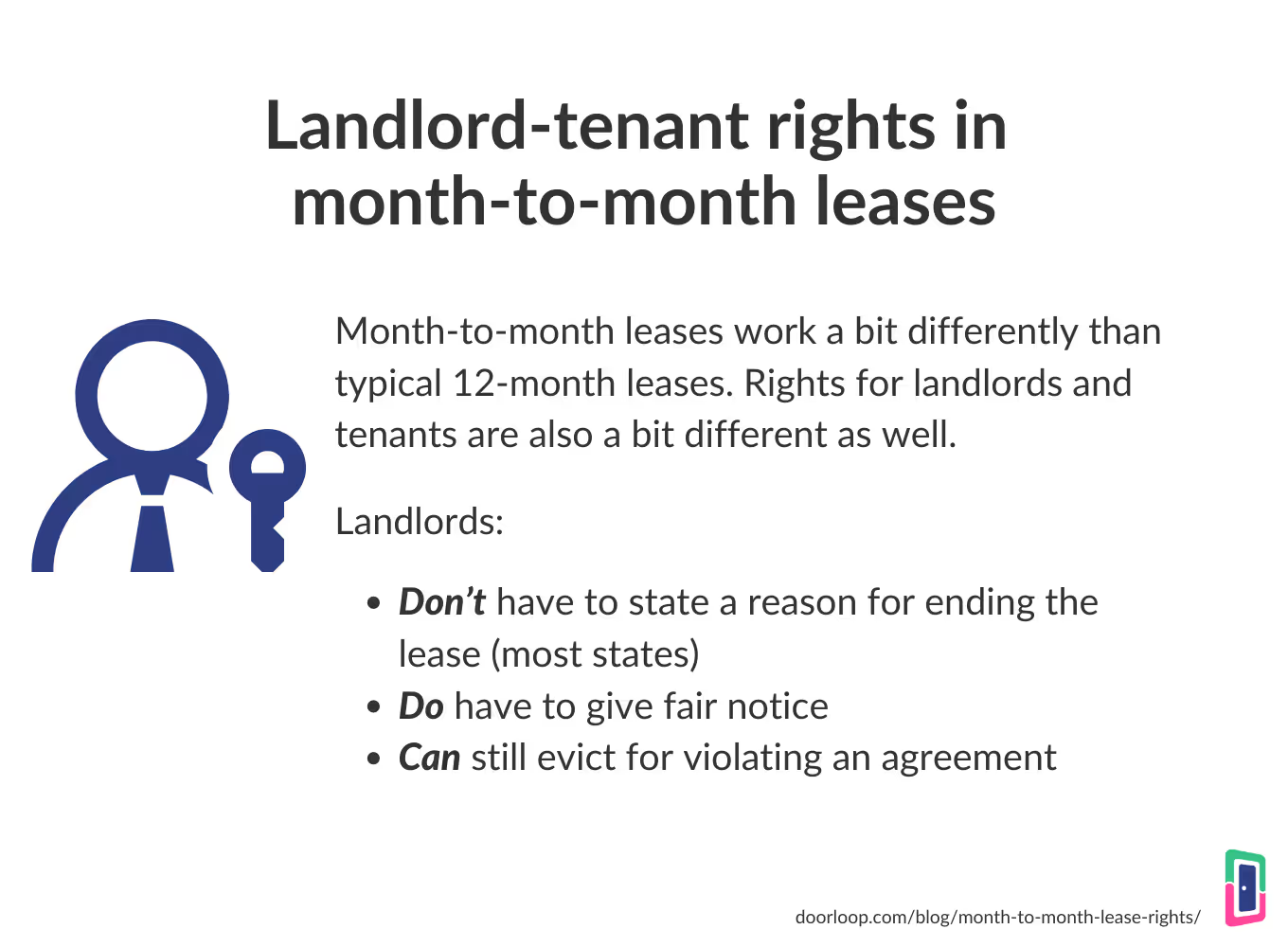While most landlords are used to ‘tenancy for years’ lease types (i.e. your average 1-year lease), there are other options.
The second most common being periodic tenancy. Specifically, a month-to-month lease.
Why use a month-to-month lease when a yearly lease does the job fine?
There are certain benefits of a month-to-month lease that you don’t get with other lease types, and situations where you might find it preferable.
First, let’s talk more about what a month-to-month lease is and its purpose.
Then, we’ll talk about how they work and landlord/tenant rights in month-to-month leases.
We’ll finish with some quick pros and cons so you have a better idea of why you might use a month-to-month lease and in what situation.
What is a month-to-month lease?
A month-to-month lease is a type of periodic tenancy where the tenant pays monthly to occupy a property without a definite expiration date.

You can even have a month-to-month tenancy without a lease agreement, as any rental arrangement without a lease agreement is typically considered month-to-month.
How it works
According to U.S. law, month-to-month tenancy is effective at the beginning of each new month.
That means if the agreement starts on the 3rd, that month’s agreement ends on the 2nd of the proceeding month.
As soon as it hits the 3rd, it’s considered a new month.
That isn’t the case for every state, however, as some have shorter periods. So, make sure to check with your state and local law to be sure.
Also, as mentioned above, a month-to-month lease doesn’t have to be bound by a lease agreement in some states.
So long as a rental arrangement is in place, it is automatically considered month-to-month.
Landlord-tenant rights
Because month-to-month leases work a bit differently than typical annual leases, they also come with somewhat different rights for tenants and landlords.

You don’t have to state a reason for ending the lease (most states)
First, ending a month-to-month tenancy is easier than a traditional lease.
In fact, in all but two states– New Hampshire and New Jersey– you’re allowed to end the month-to-month arrangement without reason.
You do have to give fair notice
Fair notice is still required in a month-to-month agreement.
That’s typically the standard 30 days, though some states are different.
Also, you can give notice in the middle of the lease term (meaning mid-month). However, that would mean the tenancy wouldn’t end until one month from the date of the notice.
With that said, state law on delivering notices is pretty diverse, so make sure to triple check your local laws as a misstep in delivering notice can lead to a big headache if the tenant wants to be difficult.
You can still evict for violating an agreement
While much is different about a month-to-month agreement, one thing that is the same is that you’re allowed to evict for violating the details of that agreement.
In that case, you typically only need to give notice up to a few days before evicting, depending on state law.
Pros and cons
Now, let’s look at some of the pros and cons of using a month-to-month lease.
When should you/can you use a month-to-month lease over a typical annual/bi-annual lease? When is it a hindrance?
Let’s talk about it.
Pro: Flexibility and less likely to get stuck with a bad tenant
One of the major pros of a month-to-month lease is the flexibility you get.
Flexibility in when you end the lease, in particular.
This makes it harder to get stuck with a bad tenant and easier to get rid of one quickly when you do.
Pro: More control over the arrangement
Because you can end the agreement sooner and more often with a month-to-month lease, you have a lot more control.
The great part is you can always ask the tenant to change to an annual lease as well if you so choose to go that route.
Pro: Adjust rent price more often
Another major pro is that you can adjust the price more often. In some states even, like New Jersey, you have a ton of flexibility in how often and how much you can raise rent, allowing you to easily keep up with inflation.
And you’ve already raised rent the (typically) one time you’re allowed in a 12-month period based on most state laws, you have the flexibility to get a new tenant more easily for a higher rent price.
Con: More volatility
Landlords aren’t the only ones with more flexibility in a month-to-month lease.
In a month-to-month lease, tenants can move without worrying about early termination fees, which means you could spend more time replacing tenants.
That’s both a time-based and financial cost to you, which may not be worth the benefits.
Con: Less certainty
Another drawback is that with a month-to-month lease, you never know when a tenant could suddenly give notice and be gone within that same month.
With a standard 12-month lease, you have the financial security that your tenant is far more likely to ride out the end of their lease, allowing you to project rental income better.
Keep yourself informed
Utilizing month-to-month leases requires that you understand the differences between them and the typical term lease such as 12 and 24-month leases.
You may or may not decide to utilize them, but they can be a useful tool in your landlord’s toolbelt in a number of scenarios where you need a little bit of added flexibility.
For more great tools and resources, check out DoorLoop’s extensive resources section: Property Management Resources.
































.svg)
.svg)

